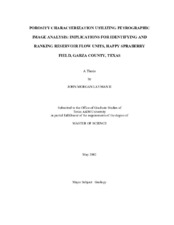| dc.description.abstract | The Spraberry Formation is traditionally thought of as deep-water turbidites in the central Midland Basin. At Happy Spraberry field, Garza County, Texas, however, production is from a carbonate interval about 100 feet thick that has been correlated on seismic sections with the Leonardian aged, Lower Clear Fork Formation. The "Happy field" carbonates were deposited on the Eastern Shelf of the Midland Basin and consist of oolitic skeletal grainstones and packstones, rudstones and floatstones, in situ Tubiphytes bindstones, and laminated to rippled, very-fine grained siltstones and sandstones. The highest reservoir "quality" facies are in the oolitic grainstones and packstones where grain-moldic and solution-enhanced intergranular porosity dominate. Other pore types present include incomplete grain moldic, vuggy, and solution-enhanced intramatrix.
The purpose of this study was to relate pore geometry measured by digital petrographic image analysis to petrophysical characteristics, and finally, to reservoir quality. Image analysis was utilized to obtain size, shape, frequency, and total abundance of pore categories. Pore geometry and percent porosity were obtained by capturing digital images from thin sections viewed under a petrographic microscope. The images were transferred to computer storage for processing with a commercial image analysis program trademarked as Image Pro Plus (Version 4.0).
A classification scheme was derived from the image processing enabling "pore facies" to be established. Pore facies were then compared to measured porosity and permeability from core analyses to determine relative "quality" of reservoir zones with different pore facies. Pore facies are defined on pore types, sizes, shapes, and abundances that occur in reproducible associations or patterns. These patterns were compared with porosity and permeability values from core analyses. Four pore facies were identified in the Happy field carbonates; they were examined for evidence of diagenetic change, depositional signatures, and fractures. Once the genetic categories were established for the four pore facies, the pore groups could be reexamined in stratigraphic context and placed in the stratigraphic section across Happy field. Finally, the combined porosity and permeability values characteristic of each pore facies were used to identify and rank good, intermediate, and poor flow units at field scale. | en |


